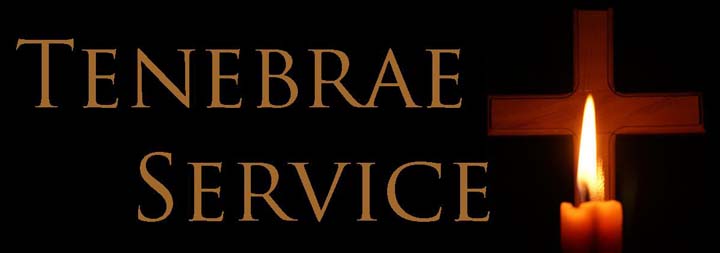This article is based on St. Peter’s Tenebrae service which is here. It is taken from the Episcopal Book of Occasional Services. Tenebrae is an ancient service the goes back to the medieval service (9th century).

Tenebrae is divided into 3 nocturns or sections and 9 lessons within them. Antiphons are excerpts from psalms said before the lesson. Responsory are responses said after a lesson.
The first part of the service is set at Matins, night time, originally celebrated a few hours after midnight. Then there is Lauds, originally celebrated at dawn. They were anticipated by the late Middle Ages on the afternoon or evening of the preceding day, and were given the name “Tenebrae” because concluding when darkness was setting in. During the 3rd nocturn there is a heading for Lauds, early morning before sunrise
The three nocturns are taken from the following sources:
- Christ as the one who weeps over Jerusalem (from The Lamentations of Jeremiah).
- The hoped-for fulfillment of the psalmist (attributed to St. Augustine).
- The true sacrifice of a broken and contrite heart (Psalm 51:17).
- The true and eternal High Priest (as described in the Letter to the Hebrews).
First Nocturn (readings from the Lamentations of Jeremiah)
In the Tenebrae service, these passages evoke a sense of darkness, abandonment, but also hope amidst suffering. They invite reflection on our own struggles and the enduring faith that sustains us.
In this nocturn, Christ is portrayed as the compassionate one who weeps over Jerusalem. The imagery draws from the book of Jeremiah, emphasizing Christ’s sorrow and love for humanity. The Lamentations of Jeremiah poignantly express grief and lamentation, underscoring the weight of sin and the need for redemption
Lesson 1,2, 3 Lamentations 1:1-14
Second Nocturn (readings from Saint Augustine’s Commentaries on the Psalms)
In the Tenebrae service, these scriptures guide believers through the darkness of Good Friday, reminding us of Christ’s suffering, His triumph over darkness, and the hope of resurrection on Easter.
St. Augustine’s writings inspire hope and anticipation. Christ is seen as the fulfillment of ancient prophecies—the long-awaited Messiah who brings salvation.
The psalmist’s yearning finds its ultimate answer in Christ’s sacrificial love, which transcends time and space
Lesson 4, Lesson 5, Lesson 6 –A reading from the Treatise of Saint Augustine the Bishop on the Psalms.
Third Nocturn (readings from New Testament epistles)
There continues to be darkness – deep despair and abandonment echoing Christ’s cry from the cross: “My God, my God, why have you forsaken me?” and his submission to God’s will. Other passages celebrate victory. Even in the darkest moments, God’s ultimate triumph is assured. Passages speak of our mortality and the hope of Christ’s resurrection. From Hebrews, Jesus acts as our compassionate High Priest who understands our weaknesses and our need for redemption and acts as the mediator between God and humanity.
Lesson 7, Lesson 8, Lesson 9 –The Letter to the Hebrews. [4:15-5:10, 9:11-15a]
Lauds – Early morning
The Song of Hezekiah [Isaiah 38:10-20]
